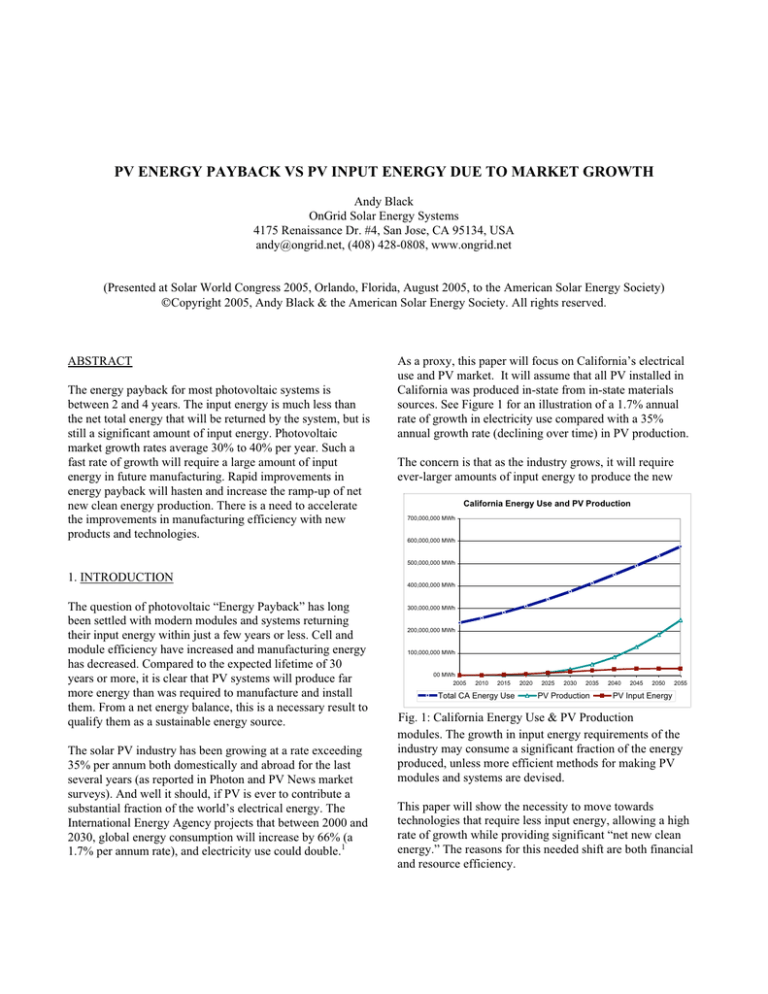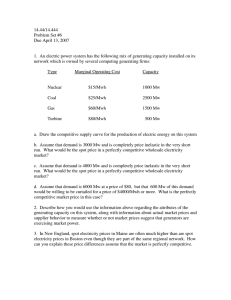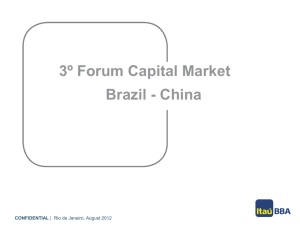
PV ENERGY PAYBACK VS PV INPUT ENERGY DUE TO MARKET GROWTH
Andy Black
OnGrid Solar Energy Systems
4175 Renaissance Dr. #4, San Jose, CA 95134, USA
andy@ongrid.net, (408) 428-0808, www.ongrid.net
(Presented at Solar World Congress 2005, Orlando, Florida, August 2005, to the American Solar Energy Society)
©Copyright 2005, Andy Black & the American Solar Energy Society. All rights reserved.
ABSTRACT
The energy payback for most photovoltaic systems is
between 2 and 4 years. The input energy is much less than
the net total energy that will be returned by the system, but is
still a significant amount of input energy. Photovoltaic
market growth rates average 30% to 40% per year. Such a
fast rate of growth will require a large amount of input
energy in future manufacturing. Rapid improvements in
energy payback will hasten and increase the ramp-up of net
new clean energy production. There is a need to accelerate
the improvements in manufacturing efficiency with new
products and technologies.
As a proxy, this paper will focus on California’s electrical
use and PV market. It will assume that all PV installed in
California was produced in-state from in-state materials
sources. See Figure 1 for an illustration of a 1.7% annual
rate of growth in electricity use compared with a 35%
annual growth rate (declining over time) in PV production.
The concern is that as the industry grows, it will require
ever-larger amounts of input energy to produce the new
California Energy Use and PV Production
700,000,000 MWh
600,000,000 MWh
500,000,000 MWh
1. INTRODUCTION
The question of photovoltaic “Energy Payback” has long
been settled with modern modules and systems returning
their input energy within just a few years or less. Cell and
module efficiency have increased and manufacturing energy
has decreased. Compared to the expected lifetime of 30
years or more, it is clear that PV systems will produce far
more energy than was required to manufacture and install
them. From a net energy balance, this is a necessary result to
qualify them as a sustainable energy source.
The solar PV industry has been growing at a rate exceeding
35% per annum both domestically and abroad for the last
several years (as reported in Photon and PV News market
surveys). And well it should, if PV is ever to contribute a
substantial fraction of the world’s electrical energy. The
International Energy Agency projects that between 2000 and
2030, global energy consumption will increase by 66% (a
1.7% per annum rate), and electricity use could double.1
400,000,000 MWh
300,000,000 MWh
200,000,000 MWh
100,000,000 MWh
00 MWh
2005
2010
2015
Total CA Energy Use
2020
2025
2030
2035
PV Production
2040
2045
2050
2055
PV Input Energy
Fig. 1: California Energy Use & PV Production
modules. The growth in input energy requirements of the
industry may consume a significant fraction of the energy
produced, unless more efficient methods for making PV
modules and systems are devised.
This paper will show the necessity to move towards
technologies that require less input energy, allowing a high
rate of growth while providing significant “net new clean
energy.” The reasons for this needed shift are both financial
and resource efficiency.
2. CURRENT ENERGY PAYBACKS
PV modules and complete systems take a lot of energy to
produce. In 1998 Alsema2 calculated an energy payback of
about 4 years for then current multi-crystalline silicon PV
systems, including module, framing, mounting hardware and
the energy input to the Balance of System (BOS). In 2000
Knapp and Jester3 studied an actual manufacturing facility
and found that, for single-crystal-silicon modules, the energy
payback time was 3.3 years. This includes the energy to
make the aluminum frames and purify and crystallize the
silicon, but does not appear to include the energy input for
the BOS components such as inverters, wiring and mounting
structures. The additional energy payback time for the BOS
is estimated to be about a half a year.
Accounting for the past seven and five years of process and
product development since Alsema’s and Knapp and Jester’s
reports, and the lag time of their reports after their data
gathering, it is estimated that current systems have an energy
payback time of 2.6 years.
the amount of electricity they can produce at retail (ie.
without subsidy).
3.2 Implications in Cost and Pollution Shifting
An assumption in the above cost of manufacture is that
electrical energy cost and pollution at all locations is
similar. This assumption is invalid because some regions
electric rates are so high that PV has become economically
viable4, while other areas have very low retail rates.
Because PV manufacturing is energy intensive, pressure
will drive manufacturing to lower cost regions, while sales
will occur in high cost regions (excluding the effect of
subsidies). It becomes clear why Shell has its ingot and
wafer facility in Washington state with its 4.36¢/kWh
average electricity cost in 2004. Other states such as
Wyoming, Utah and Kentucky also have low average
electricity cost5 (see Figure 2.) but much of their electricity
comes from coal.
3. ENERGY REQUIRED TO SUPPORT GROWTH
Given a stabilized growth rate, and an installed base of PV,
if the energy payback time is 4 years, the industry will
consume all the energy output of the installed base if it
grows at a 25% rate. That is, if there is 100 MW installed,
that 100 MW could supply energy for the manufacture and
installation of 25 MW of new systems based on the 4-year
energy payback rate. The following year, the now 125 MW
installed base could support one quarter of 125 MW, or
31.25 MW of new systems, for a net production growth of
25% year-over-year.
This becomes a cycle that could continue indefinitely. An
example could be: All the modules made to date produce
just enough energy to produce this year’s crop of new solar
modules. This year’s crop, plus all the ones made before will
produce just enough energy to make next year’s crop, etc.
3.1 Implications in Cost of Manufacture
If the industry is using in its growth as much energy as it is
producing from its installed base, and the energy on either
side of the equation has a similar retail value in all locations
(a hypothetical assumption), it leaves no monetary budget in
the manufacturing process for other inputs such as labor and
raw materials (assuming the energy needed to produce the
raw material is already counted in the PV input energy), and
no margin to cover overhead, profit, etc. The cost of
manufacturing next year’s modules will always be more than
this year’s panels can be sold for, if they are valued based on
Fig. 2: State average retail electricity costs.
3.3 Variables
Energy Payback Period (in years): A long energy payback
means a lower industry growth rate can be supported
without requiring additional input energy. See Table 1 for
various growth rates that can be supported for
corresponding Energy Payback periods. The Energy
Payback period as of 2005 is assumed to be 2.6 years for
purposes of the initial analysis. This is an estimation based
on the Alsema2 and Knapp and Jester3 studies, which are 7
and 5 years old, assuming manufacturing has gotten more
efficient in that time.
TABLE 1: GROWTH VS. PAYBACK
Industry Initial Growth Rate: 35% in 2005.
Industry Growth Rate Reduction Factor: This is the rate
at which the industry is estimated to slow down. Large
industries tend to grow more slowly than small ones. As of
2004, the PV industry is still considered very small, so a
35% growth rate, while exceptional, is not unheard of.
However, at this rate of growth, the industry will soon be
large. One reason the industry’s growth must eventually
slow is because the input capital requirements will become
very large, even by the financial market’s measures. Shell6
has estimated that at an annual growth rate of 25%, in 10
years, the industry will need $200 Billion in working capital
and capital finance funds. For purposes of this study, a 3.5%
annual growth rate reduction factor will be applied.
3.00 yrs
50.0%
45.0%
2.50 yrs
40.0%
35.0%
2.00 yrs
30.0%
25.0%
1.50 yrs
20.0%
1.00 yrs
15.0%
10.0%
0.50 yrs
5.0%
0.00 yrs
2005
2010
2015
2020
2025
2030
2035
2040
2045
2050
Growth Rates and PV's Proportion of
CA Mix
Self Sustaining, Energy
Neutral Growth Rate
20%
25%
33%
50%
100%
Energy Payback Period
Energy Payback
Period
5 years
4 years
3 years
2 years
1 year
Energy Payback, Industry Growth Rate,
& Proportion of CA Energy Mix over Time
0.0%
2055
Years to Payback
PV industry annual growth rate
PV production percent of CA energy mix
Fig. 3: Energy Payback Period and Industry Growth Rates
Net New Energy from PV
90,000,000 MWh
80,000,000 MWh
70,000,000 MWh
60,000,000 MWh
50,000,000 MWh
40,000,000 MWh
30,000,000 MWh
20,000,000 MWh
PV Energy Payback Reduction Factor: The industry is
getting more efficient at producing wafers, cells, modules,
and systems, requiring less input energy and producing more
output energy, thus shortening energy payback periods. A
6.0% annual energy payback reduction factor is assumed for
our initial analysis. The actual rate is unknown at this time
and could be higher, or become higher as new technologies
emerge that could significantly reduce the input energy
requirements.
Other input variables include:
93 MW installed PV capacity through 2004 in California7
26,300 MW average California electrical load8
1.7% annual growth rate in average electrical load
1300 AC kWh PV production per year per DC kW of
installed capacity
3.4 Initial Analysis
10,000,000 MWh
00 MWh
-10,000,000 MWh
2005
2010
2015
2020
2025
2030
2035
2040
PV Production
Net New Energy From PV
PV Input Energy
Initial growth rate: 35%, annual reduction: 3.5%
Initial payback: 2.6 yrs, annual reduction: 6%
st
Fig. 4: Net New Energy from PV, 1 scenario.
Cumulative and Annual Net New Energy from PV
1,600,000,000 MWh
1,400,000,000 MWh
1,200,000,000 MWh
1,000,000,000 MWh
800,000,000 MWh
600,000,000 MWh
400,000,000 MWh
Figure 3 shows reduction in Energy Payback Period and
Industry Growth Rates over 50 years assuming the above
rate reduction factors. In 2055, an industry growth rate of
6% when the industry is supplying 43% of California’s
electricity is rapid, but perhaps not inconceivable.
Figure 4 shows the results of an analysis based on the values
of the variables in section 3.3. The results show that PV
Production output energy ramps up nicely starting around
2020. However, PV input energy remains significant until
200,000,000 MWh
-
MWh
(200,000,000) MWh
2005
2010
2015
2020
2025
2030
Cumulative Net New Energy
2035
2040
2045
2050
Annual Net New Energy
Fig. 5: Cumulative and Net New Energy from PV
about 2025, after which, the industry explodes in terms of
production of net new energy as shown in Figure 5.
3.5 Sensitivity of the Variables
50.0%
45.0%
2.00 yrs
40.0%
35.0%
1.50 yrs
30.0%
25.0%
1.00 yrs
20.0%
15.0%
0.50 yrs
10.0%
5.0%
0.00 yrs
2005
2010
2015
2020
2025
2030
2035
2040
2045
2050
Growth Rates and PV's Proportion of
CA Mix
The Industry Growth Rate Reduction Factor has a very
strong affect on the long-term proportion of PV energy in
the California energy mix. It does not affect when the rampup occurs in the production of net new energy, but it does
affect the magnitude of production.
2.50 yrs
Energy Payback Period
The Industry Initial Growth Rate has a strong affect on the
long-term proportion of PV energy in the California energy
mix. It does not affect when the ramp-up occurs in the
production of net new energy, but it does affect the
magnitude of production.
Energy Payback, Industry Growth Rate,
& Proportion of CA Energy Mix over Time
0.0%
2055
Years to Payback
PV industry annual growth rate
PV production percent of CA energy mix
Initial Payback period has a major affect on what year the
ramp-up occurs. It has a minor affect on annual and
cumulative production of net new energy.
Net New Energy from PV
90,000,000 MWh
The rate at which the industry reduces the payback period
has the strongest affect of all factors regarding when the
ramp-up occurs. It has a minor affect on annual and
cumulative production of net new energy.
80,000,000 MWh
70,000,000 MWh
60,000,000 MWh
50,000,000 MWh
40,000,000 MWh
3.6 Analysis Assuming Faster Payback
30,000,000 MWh
20,000,000 MWh
Rerunning the analysis assuming a 2-year initial payback
and a faster improvement in production efficiency of 7% per
year (faster reduction in energy payback) shows a scenario
where the production of net new energy ramps up sooner
and faster, starting in 2020. See Figure 6. This scenario
might occur if the industry successfully shifts to new, less
energy intensive technologies sooner.
10,000,000 MWh
00 MWh
-10,000,000 MWh
2005
2010
2015
2020
2025
2030
2035
2040
PV Production
Net New Energy From PV
PV Input Energy
Initial growth rate: 35%, annual reduction: 3.5%
Initial payback: 2 yrs, annual reduction: 7%
Cumulative and Annual Net New Energy from PV
CONCLUSION
1,800,000,000 MWh
The next 20 years will serve as an incubation period until the
production of net new PV energy begins to explode around
2025. By 2055, the PV industry is capable of producing over
40% of California’s electrical energy needs.
1,600,000,000 MWh
1,400,000,000 MWh
1,200,000,000 MWh
1,000,000,000 MWh
800,000,000 MWh
Energy payback periods have been steadily improving. The
above results can be achieved sooner by more quickly
improving energy payback periods.
600,000,000 MWh
400,000,000 MWh
200,000,000 MWh
-
RECOMMENDATIONS
MWh
(200,000,000) MWh
2005
2010
2015
2020
2025
2030
Cumulative Net New Energy
To make faster progress in supplying a large quantity of net
new energy, the industry must improve the energy payback,
through technology and manufacturing improvements.
An increased focus on energy optimization as part of cost
optimization may naturally occur if energy costs continue to
rise.
2035
2040
2045
2050
Annual Net New Energy
Fig. 6: Faster payback scenario.
Increase funding for research in technologies with high
probability of accelerating improvements in energy
payback. Thin film technologies hold high promise of using
very low energy processes and very small amounts of
material. Alsema2 projects the payback for thin-film PV
REFERENCES
would drop to just 1 year by 2009. CuInSe2 and CdTe
modules are already being sold in the 9%–12% efficiency
range, so their energy payback may be less than a year9.
More research funding will aid this important area.
(1) Sawin, J., Mainstreaming Renewable Energy in the 21st
Century, Renewable Energy World, July-August 2004, p.42
(2) Alsema, E., Energy Requirements and CO2 Mitigation
Potential of PV Systems, Workshop Proceedings of
Photovoltaics and the Environment, Keystone, CO, 1998
(3) Knapp, K. & T.L. Jester, An Empirical Perspective on
the Energy Payback Time for PV Modules, Proceedings of
the 29th ASES Annual Conference, The American Solar
Energy Society, June 2000
(4) Black, A., Financial Payback on California Solar
Electric Systems, Proceedings of the 32nd ASES Annual
Conference, The American Solar Energy Society, July 2003
(5) US DOE Energy Information Administration,
Electricity Retail Price Fact Sheet,
www.eia.doe.gov/cneaf/electricity/page/fact_sheets/retailpri
ce.html, January 31, 2005
(6) Handelsman, G, Perspective from the Solar Industry,
Solar Power 2004 Conference, Solar Electric Power
Association, October 2004
(7) California Energy Commission, Grid-Connected PV
Capacity (kW) Installed in California,
www.energy.ca.gov/renewables/emerging_renewables/200
5-01-18_GRID_PV.PDF, January 18, 2005
(8) Department of Market Analysis, California ISO, Annual
Report on Market Issues and Performance,
2004041515470827042.pdf, April 2004
(9) US DOE, Energy Efficiency and Renewable Energy,
What is the Energy Payback for PV?, PV FAQs, DOE/GO102004-1847, January 2004
Favored technologies will have the lowest relative input
energy requirements when accounting for the entire system,
and will result in manufacturing and production cost
advantages in the marketplace. New thin film cells will still
need to be encapsulated and mounted, but the cell input
energy could be dramatically reduced. The higher the
efficiency of these thin films, the less mounting and
encapsulation material and energy will be required, further
boosting their net results. Eliminating module frames and
reducing the use of aluminum in the support structure would
be a further improvement9.
To improve the accuracy of this study, more effort is needed
on the projected industry growth rates and projected
improvements in energy paybacks, particularly in the novel
technologies.
This study has only focused on California, which has a head
start along with Germany & Japan. Other parts of the world
are further from establishing a major inflow of net new clean
energy. However, once they get started, they will benefit
from the interim improvements in energy payback.
Initial growth rate: 35%, annual reduction: 3.5%
Initial payback: 2.6 yrs, annual reduction: 6%
PV industry 2005 growth rate
PV growth rate reduction factor (% per year)
Initial years to PV energy payback
PV energy payback reduction factor (% per year)
35%
3.5%
2.6 years
6.0%
CA avg electric load in 2003. Source: 2003 CA ISO Market Rep
CA total electrical energy use growth rate, excluding PV input
PV total installed capacity in CA thru 2004. Source: CEC
AC kWh PV production per year per DC kW installed capacity
26,329 MW
1.7%
93 MW
1,300 AC kWh
Year
CA energy use, excluding PV input energy
PV manufacturing & installation input energy
Total CA energy use, including PV input energy
2004
2005
2010
2015
2020
2025
230,642,040 MWh
449,821 MWh
231,091,861 MWh
234,562,955 MWh
567,686 MWh
235,130,641 MWh
255,190,315 MWh
1,569,701 MWh
256,760,016 MWh
277,631,636 MWh
3,575,764 MWh
281,207,400 MWh
302,046,437 MWh
6,884,866 MWh
308,931,303 MWh
328,608,265 MWh
11,464,711 MWh
340,072,975 MWh
35.0%
29.3%
24.5%
20.5%
17.2%
93 MW
120,900 MWh
126 MW
163,215 MWh
493 MW
641,357 MWh
1,588 MW
2,064,979 MWh
4,302 MW
5,592,088 MWh
10,031 MW
13,039,820 MWh
PV industry annual growth rate
Installed PV Capacity
Annual derated PV energy production (=MW*1300)
PV production percent of CA energy mix
Cumulative PV production starting in 2004
Years to PV system energy payback
Net new energy from PV (annual)
Cumulative net new energy from PV (production minus input)
0.05%
0.07%
0.25%
0.73%
1.81%
3.83%
120,900 MWh
284,115 MWh
2,309,941 MWh
9,225,604 MWh
28,974,525 MWh
77,270,160 MWh
2.76 yrs
2.60 yrs
1.91 yrs
1.40 yrs
1.03 yrs
0.75 yrs
(328,921) MWh
(328,921) MWh
(404,471) MWh
(733,392) MWh
(928,344) MWh
(4,232,279) MWh
(1,510,785) MWh
(10,705,126) MWh
(1,292,778) MWh
(18,216,446) MWh
1,575,109 MWh
(17,638,313) MWh
2030
2035
2040
2045
2050
2055
357,505,927 MWh
16,850,527 MWh
374,356,455 MWh
388,944,837 MWh
22,254,980 MWh
411,199,817 MWh
423,148,471 MWh
26,828,828 MWh
449,977,299 MWh
460,359,957 MWh
29,925,296 MWh
490,285,252 MWh
500,843,804 MWh
31,248,780 MWh
532,092,584 MWh
544,887,782 MWh
30,857,779 MWh
575,745,561 MWh
14.4%
12.0%
10.1%
8.4%
7.0%
5.9%
20,565 MW
26,734,423 MWh
37,759 MW
49,086,102 MWh
63,093 MW
82,020,445 MWh
97,295 MW
126,483,833 MWh
140,153 MW
182,199,341 MWh
190,559 MW
247,726,739 MWh
7.14%
11.94%
18.23%
25.80%
34.24%
43.03%
180,558,136 MWh
377,380,666 MWh
717,106,125 MWh
1,255,950,006 MWh
2,051,225,498 MWh
3,155,291,464 MWh
0.55 yrs
0.41 yrs
0.30 yrs
0.22 yrs
0.16 yrs
0.12 yrs
9,883,895 MWh
12,348,994 MWh
26,831,122 MWh
108,536,851 MWh
55,191,617 MWh
322,781,586 MWh
96,558,537 MWh
717,513,841 MWh
150,950,560 MWh
1,358,471,459 MWh
216,868,960 MWh
2,306,829,538 MWh
Fig. 7: Raw data from the model.
Year
CA energy use, excluding PV input energy
PV manufacturing & installation input energy
Total CA energy use, including PV input energy
PV industry annual growth rate
Installed PV Capacity
Annual derated PV energy production (=MW*1300)
PV production percent of CA energy mix
Cumulative PV production starting in 2004
Years to PV system energy payback
Net new energy from PV (annual)
Cumulative net new energy from PV (production minus input)




